Pandas Dataframe: Merge and Join Examples
Last updated:- pd.merge example
- pd.merge by index
- Join on multiple columns
- merge vs join
- pd.merge() vs dataframe.join() vs dataframe.merge()
- Rename duplicate columns
- merge_asof example
WIP Alert This is a work in progress. Current information is correct but more content may be added in the future.
View examples on this jupyter notebook
pd.merge example
The default is an inner join. Use 'how'='left'|'right'|'outer' to change join types.
import pandas as pd
pd.merge(
left_dataframe,
right_dataframe,
left_on= column_on_left_dataframe,
right_on= column_on_right_dataframe)
pd.merge by index
Joins by index are much faster than join on arbitrary columns!
If the columns you want to join on are Indices, use left_index and right_index.
Use 'how'='left'|'right'|'outer' to change join types. The default join type is "left":
pd.merge(
left_dataframe,
right_dataframe,
left_index=True,
right_index=True)
Join on multiple columns
Joining by multiple columns is useful for dealing with time-stamped data.
Just pass an array of column names to left_on and right_on:
import pandas as pd
df_employees_sal = pd.DataFrame({
'year':[1980,1981,1980,1981,1980,1981,1980,1981],
'id':[1,1,2,2,3,3,4,4],
'name':['alice','alice','bob','bob','charlie','charlie','david','david'],
'salary':[30000,30000,40000,41000,35000,40000,45000,45000],
'company_id':[1,1,2,2,1,1,2,2]})
df_companies_rev = pd.DataFrame({
'year':[1980,1981,1980,1981],
'id':[1,1,2,2],
'name':['bell labs','bell labs','xerox','xerox'],
'revenue':[1130000,1130000,5000000,500000]})
pd.merge(
df_employees_sal,
df_companies_rev,
left_on=['year','company_id'],
right_on=['year','id']
)
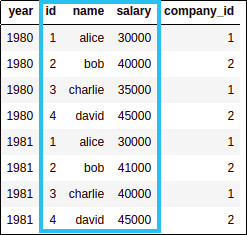 LEFT: employees and
LEFT: employees and annual salaries
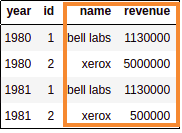 RIGHT: companies and
RIGHT: companies and annual revenue
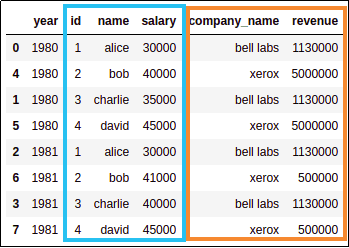 MERGED using
MERGED using year and company_id as keys
merge vs join
Joining by index (using
df.join) is much faster than joins on arbtitrary columns!
The difference between dataframe.merge() and dataframe.join() is that with dataframe.merge() you can join on any columns, whereas dataframe.join() only lets you join on index columns.
pd.merge() vs dataframe.join() vs dataframe.merge()
TL;DR: pd.merge() is the most generic. df.merge() is the same as pd.merge() with an implicit left dataframe. Use df.join() for merging on index columns exclusively. df.join is much faster because it joins by index
| pandas.merge | dataframe.join | dataframe.merge | |
|---|---|---|---|
| How to call | Pandas global method | Dataframe method | Dataframe method |
| Join on | Join on any column | Join on index columns only | Join on any column |
| Performance | Slow unless using indices | Fast! | Slow unless using indices |
| Example | pd.merge(left_df, right_df) | left_df.join(right_df) | left_df.merge(right_df) |
| Equivalent to (i.e. how to write it using pd.merge) | - | | |
Rename duplicate columns
Pass suffix=(<suffix_for_left>,<suffix_for_right>) to pd.merge():
import pandas as pd
df_employees_sal = pd.DataFrame({
'year':[1980,1981,1980,1981,1980,1981,1980,1981],
'id':[1,1,2,2,3,3,4,4],
'name':['alice','alice','bob','bob','charlie','charlie','david','david'],
'salary':[30000,30000,40000,41000,35000,40000,45000,45000],
'company_id':[1,1,2,2,1,1,2,2]})
df_companies_rev = pd.DataFrame({
'year':[1980,1981,1980,1981],
'id':[1,1,2,2],
'name':['bell labs','bell labs','xerox','xerox'],
'revenue':[1130000,1130000,5000000,500000]})
# suffixes takes a tuple with the suffix values for duplicate columns coming
# from the left and right dataframes, respectively
pd.merge(
df_employees_sal,
df_companies_rev,
left_on=['year','company_id'],
right_on=['year','id'],
suffixes=('_left','_right')
)
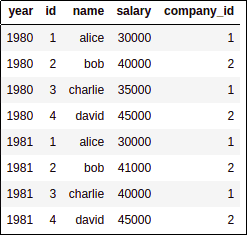 LEFT: employess and
LEFT: employess and annual salaries
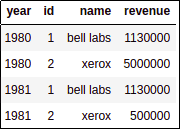 RIGHT: companies and
RIGHT: companies and annual revenue
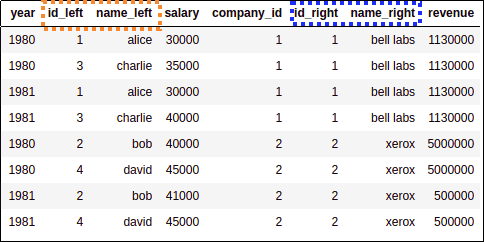 MERGED: Newly named columns are
MERGED: Newly named columns are left (orange) and right (blue) Note that column year was not duplicated,
pandas correctly identified it
was the same in both sides.
merge_asof example
TODO